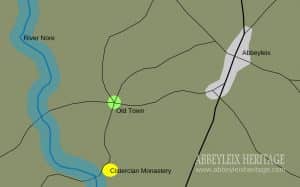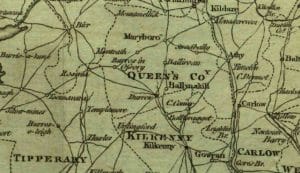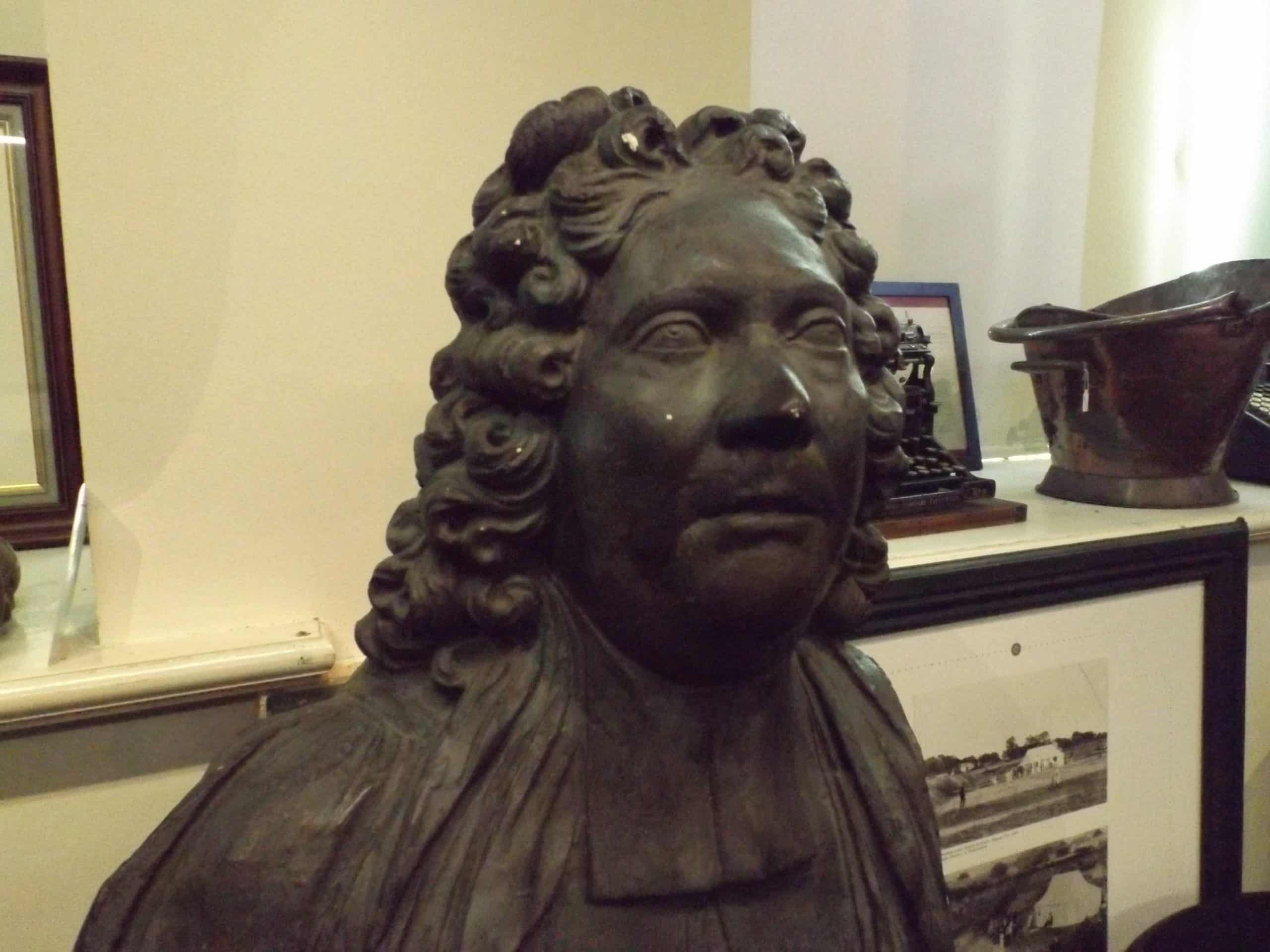By 1770 Thomas Vesey, 1st Viscount de Vesci had finally managed to resolve the legal issues that dogged the estate since his grandfather had inherited it almost 80 years previously. With these issues behind him he could finally start to build an estate in his image, reflecting his values and beliefs.

The old village of Abbey Leix had grown up around the Medieval monastery built in 1183. The Cistercians, like many medieval monastic orders, would have built their monastery in close proximity to good sites for milling. This was of vital importance at the time as transport was difficult and there was no chance the foundation could thrive without food, and cereals were a large part of the daily diet. At this point along its course the River Nore is joined by a number of small tributaries and the land is quite flat making it very easy to dig head races and ponds for these mills. Unfortunately the very landscape that made the location so suitable for milling also made it extremely prone to flooding and to the present day the river can increase from 10-15m wide to 50-100m wide in a matter of hours during the winter and times of flood.

We actually know very little about the location of the old town. Archaeological logic and comparisons with the locations of similar institutions would suggest the original village grew up around the monastery somewhere in the vicinity of ‘Home Farm’ and the old Church of Ireland church. The presence of a nearby townland called ‘Old Town’ leads to some confusion, but this may be the result of a split in the village, the original location was so bad that even by 1770 some people had already moved to a better location on higher ground. When the decision was made to create a new town it was only sensible to unite all the buildings to create a critical mass of population that would have a better chance of success. The only real reference to the old town comes from an early travel writer Thomas Dineley. He spent a night at an inn called the Sign of The Cock in ‘Abbey Lease‘ while travelling from Carlow to Limerick in 1681, the village was so nondescript that he describes the inn landlord and his wife but makes no other mention of the village.
The poor location of the old town and the growing trend for the owners of large estates to build their own planned towns, more than 800 towns were either completely rebuilt in a new layout or heavily remodelled between 1700 and 1845, away from the estate house lead to the building of the new town a few miles north of the old town. This town was very deliberately positioned on the recently constructed turnpike road linking Dublin to Tipperary and ultimately Cork. The old town had never been on the main road, that had run through Ballyroan and Ballinakill, but when the new road was positioned much closer to the estate the opportunity was there to develop something special. The status of Abbeyleix at this time can be noted from the Taylor and Skinner road atlas of 1777, Ballyroan is shown on one map, and Ballinakill on three, being a destination in its own right on two of them, ‘Ballynakill to Athy‘ and ‘Kilkenny to Ballynakill‘. Abbeyleix is noted on a single map as a house, the residence of Viscount de Vesci.

Through the years the town would continue to develop, the Georgian architecture that marks much of the original phase of development of the new town was followed by Victorian and the Edwardian style buildings. Schools were built. markets and fairs developed and in 1865 the railway came to the town. The new town would thrive in comparison to its more historic neighbours.


Marvelous stuff…Surely there is some evidence of the ‘old’ town..Has it ever been search for (from an Archeological point of view)?
Ariel Photography and cartography have been used to no no avail, the area has been heavily landscaped over the past 250 years. There are no extant maps of that are pre late 18th century, the down survey parish map is one of the destroyed. As far as I can determine no Lidar has been done of the area which might show up something, and no geophysics or testing have been carried out. The visit carried out by the Archaeological Survey of Ireland was the usual cursory affair, it’s a bit of a joke at this stage.
Personally I don’t know how much would remain of the old town anyway, a lot of vernacular domestic buildings in the midlands are mud built so there might be nothing in the ground other than a beaten earth floor and a fire spot. The monastery should have left more substantial remains even if it’s no more than robbed out foundation trenches. It would be great if we could get some work done to find the monastery.
Very interesting article.
Is there any historical information regarding when the terraced houses on New Row with the verandas were built? Presumably as part of the ‘New Town’ project around 1770, but is there any year or decade on record in which building commenced?
I’m not 100% sure which houses you mean but I’m assuming the ones opposite the FEC. There are a terrace of houses at that location on the 1st edition of the Ordinance Survey, dates to 1830’s but the the shape of the back of the houses change by the 1909 version. Personally I’ve never come across any details about the construction of these houses but there may be some records in the De Vesci Archives in the National Library of Ireland.
From the style of the terrace it appears to be influenced by the Arts and Crafts Movement that was very strong in England from about 1880 to 1910, this would fit in a lot of reconstruction of labourers around the town, Blue Gate, Sweet View, Old Town etc.
Thanks for your reply. Yes, the houses opposite the FEC school are the ones I was enquiring about. I thought 1830’s also, many changes have been made since. Their design seems quite unique, the mixture of architectural style, veranda and terrace doesn’t seem to have been copied in many other towns/counties, or have you seen or heard of a terraced row like these houses? If so, they may have been built around the same time.
Off the top of my head I can’t think of any exact examples elsewhere but there are somewhat similar examples in Roscrea where there is a terrace going out the Kinnity Road of houses with porches over the doors, these houses would be far more similar in style to the Bluegate Cottages that the houses in question. I’m going to have to keep my eyes open for any similar houses, if I find any I’ll let you know.
Richard there are a nunmber of terraces of houses quite similar in Birr (Parsonstown) for example Eden Cottages on the Eden Road. My grandmother lived in a terrace row which was demolished in the 1970’s and they were laborers cottages belonging to the Birr Castle estate owned by the Earls of Rosse, a relation of Tom De Vesci. There are remarkable similarities in the vernacular styles of these houses as they have a distinctly “English” appearance as do many of the other similar estate terraces, such as Sweetview Terrace on the Ballacolla Road.
There are a lot of similarities to Birr, albeit a much bigger town (5,000+) and given the strong historical relationship between the landlord and the town and the town which were originally tenants. Birr Castle on one hand is tucked into the town, whereas Abbeyleix is now at some distance removed from the Abbeyleix Demesne and Abbeyleix House.
Are there records of the English who were first ‘planted’ in this area?
My 4th great-grandfather, Henry Stone worked for the Abbeyleix Woolen Mills circa 1800 (born probably between 1775-1780); my 5th great-grandfather Arthur Whittaker worked as ‘under-steward’ to the lord of the manor at Abbeyleix circa 1790 (born around 1760).
Henry married a Mary White, cousin to Lord White of Abbeyleix House. Another cousin, one Edward White who’s property in Abbeyleix was called ‘Fruitlawn’.
Really interesting Maureeen and of course Fruitlawn is still going strong. We will have to look more into Lord White and Henry Stone. And apologies for the delay in replying, our notification for comments was out of action for ages.
Very interesting comment Maureen on your 4th great-grandfather Henry Stone. I have done a lot of research on my family tree and an Avice Stone married William Bellingham Swan in 1829 and moved in to Capponellan House in the townland of Capponellan on the Ashbrook Estate in Durrow, a few miles south of Abbeyleix. William was a land agent on that estate.
Avice would be my 3rd great-grandmother. I have been unable to trace back her ancestry but your Henry Stone looks promising. Do you have any information on his children?
Great post however I was wondering if you could write a litte more
on this subject? I’d be very thankful if you could elaborate
a little bit more. Kudos!
I believe what you posted was actually very reasonable. But, consider this,
suppose you added a little information? I am not saying your information isn’t good., but what
if you added a post title to maybe grab a person’s attention? I mean Abbeyleix – Why Build
New Town | Heritage House Abbeyleix is kinda vanilla.
You might look at Yahoo’s home page and watch how they write post titles to grab viewers to open the links.
You might add a related video or a picture or two to grab people excited about what you’ve
got to say. Just my opinion, it might bring your blog a little bit more interesting.
Wow that was odd. I just wrote an extremely long comment but after I clicked submit
my comment didn’t appear. Grrrr… well I’m not writing all
that over again. Anyways, just wanted to say excellent blog!
I don’t even know how I stopped up right here, however I assumed this put up used to be great.
I don’t realize who you are but certainly you’re going to
a famous blogger in case you are not already.
Cheers!
My spouse and I stumbled over here from a different web page and thought I
may as well check things out. I like what I see so
now i’m following you. Look forward to looking at your web
page for a second time.
I truly appreciate this article.Thanks Again. Want more.
Hello there! Would you mind if I share your blog with my twitter group?
There’s a lot of people that I think would really enjoy your content.
Please let me know. Cheers
I know this if off topic but I’m looking into starting my own blog and
was curious what all is required to get setup? I’m assuming having a blog like
yours would cost a pretty penny? I’m not very internet savvy so I’m not 100% sure.
Any tips or advice would be greatly appreciated. Thanks
Hi it’s me, I am also visiting this web page daily, this web site
is really nice and the viewers are truly sharing fastidious thoughts.
I’m impressed, I must say. Rarely do I come across a blog
that’s equally educative and amusing, and without a doubt, you have hit the nail on the head.
The problem is an issue that not enough people are speaking intelligently about.
Now i’m very happy I stumbled across this during my hunt for something concerning this.
Of course not, thank you for sharing.
I am really inspired with your writing skills and also with the format in your weblog.
Is this a paid topic or did you modify it your self?
Anyway stay up the nice quality writing, it is rare to look a
nice blog like this one these days..
Excellent post but I was wanting to know if you could write a litte more on this topic?
I’d be very thankful if you could elaborate a little bit more.
Kudos!
Hi Maureen,
Read your post and believe Arthur Whittaker of Abbeyleix is also my 5th Great Grandfather, Would be interested in corresponding to learn more.
Carter